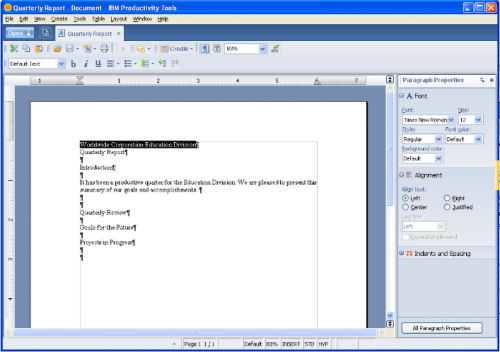IBM Revives 'Lotus Symphony,' Supports ODF Format
In a clever marketing move that had some of us fooled, IBM revealed today it was doing much more than beginning the process of rebuilding its own applications suite. In fact, Beta 1 of the new Lotus Symphony is already under way.
It's not so much a symphony, I wrote in a 1984 review of Lotus Symphony, but a cacophony. Lotus, I said, fails to make the value proposition about why users should invest nearly a thousand dollars in software whose components collectively sell for less than that, and whose best in class includes the best spreadsheet at that time, Lotus 1-2-3.
Well, 23 years later, IBM seems to have an intriguing answer to that problem. Lotus Symphony is once again an active brand, the product of IBM having successfully fooled everyone into thinking it was just now developing, or beginning to develop, a new applications suite in cooperation with Sun Microsystems. That's extremely clever marketing, especially coming from IBM. In fact, the project is quite a ways along, having entered the public Beta 1 phase today.
The new Symphony will incorporate much of the internal engine of OpenOffice (principally developed under the guidance of Sun), along with its support of the OpenDocument Format. As such, it will be offered under a public license, although whether that license is the GPL or another public license will soon be determined.
At first glance, it's obvious that Symphony's appeal is that it tries not to be revolutionary. In fact, it clearly makes a play for the customer Microsoft may have abandoned in its shift to the completely overhauled front-end model of Office 2007. It maintains an old, familiar menu bar with function arrangements that seem logical, and a right-side palette that presents the active properties of whatever object is beneath the cursor or cell pointer.

That said, IBM doesn't appear to be making a play for the corporate IT decision maker here - the person who may already be committed to purchasing multi-seat licenses for Office. Its marketing approach is geared toward the individual user - moreover, to the person who may be frustrated with the thought of buying something expensive, and learning to use something counter-intuitive and uninspiring.
If IBM can achieve a higher degree of reliability than Sun has managed, it may have an opportunity to clinch a respectable segment of the office applications market. Think Firefox for a moment - remember how an open-source project could make a value proposition that played into Microsoft's weakness, with the fact that even its mass of users aren't particularly enamored with the manufacturer.
Sun hasn't been able to crack the applications market the same way, among other reasons, because it can't sell businesses on the idea of OpenOffice use as a skill that it can shop for when advertising their open job positions. Microsoft Office is entrenched because not only do customers depend on its support base, its support base depends on them.
But there still may be a few disenchanted customers who may yet be shaken, and for them the message from IBM is, come home to something a bit more familiar, less daunting, and more direct and to the point. Even if IBM cracks a few percentage points with this approach, there will be some who would call that a success.
